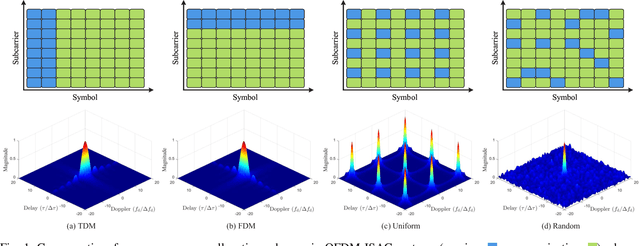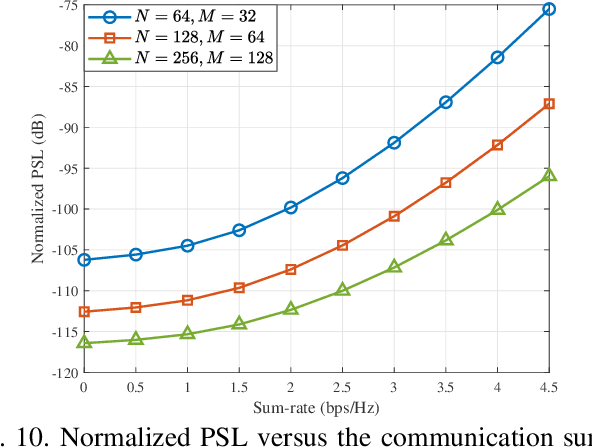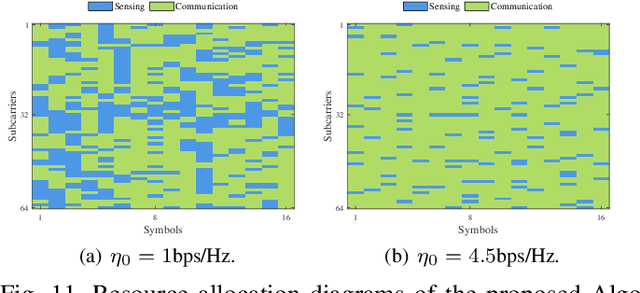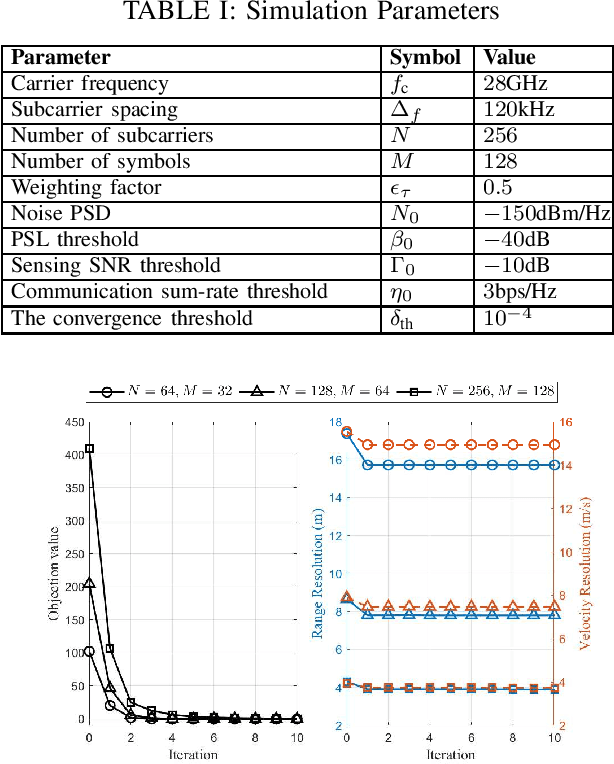Rang Liu
Graph Learning for Cooperative Cell-Free ISAC Systems: From Optimization to Estimation
Jul 09, 2025Abstract:Cell-free integrated sensing and communication (ISAC) systems have emerged as a promising paradigm for sixth-generation (6G) networks, enabling simultaneous high-rate data transmission and high-precision radar sensing through cooperative distributed access points (APs). Fully exploiting these capabilities requires a unified design that bridges system-level optimization with multi-target parameter estimation. This paper proposes an end-to-end graph learning approach to close this gap, modeling the entire cell-free ISAC network as a heterogeneous graph to jointly design the AP mode selection, user association, precoding, and echo signal processing for multi-target position and velocity estimation. In particular, we propose two novel heterogeneous graph learning frameworks: a dynamic graph learning framework and a lightweight mirror-based graph attention network (mirror-GAT) framework. The dynamic graph learning framework employs structural and temporal attention mechanisms integrated with a three-dimensional convolutional neural network (3D-CNN), enabling superior performance and robustness in cell-free ISAC environments. Conversely, the mirror-GAT framework significantly reduces computational complexity and signaling overhead through a bi-level iterative structure with share adjacency. Simulation results validate that both proposed graph-learning-based frameworks achieve significant improvements in multi-target position and velocity estimation accuracy compared to conventional heuristic and optimization-based designs. Particularly, the mirror-GAT framework demonstrates substantial reductions in computational time and signaling overhead, underscoring its suitability for practical deployments.
Impact of Insufficient CP on Sensing Performance in OFDM-ISAC Systems
May 02, 2025Abstract:Orthogonal frequency-division multiplexing (OFDM) is widely considered a leading waveform candidate for integrated sensing and communication (ISAC) in 6G networks. However, the cyclic prefix (CP) used to mitigate multipath effects in communication systems also limits the maximum sensing range. Target echoes arriving beyond the CP length cause inter-symbol interference (ISI) and inter-carrier interference (ICI), which degrade the mainlobe level and raise sidelobe levels in the range-Doppler map (RDM). This paper presents a unified analytical framework to characterize the ISI and ICI caused by an insufficient CP length in multi-target scenarios. For the first time, we derive closed-form expressions for the second-order moments of the RDM under both matched filtering (MF) and reciprocal filtering (RF) processing with insufficient CP length. These expressions quantify the effects of CP length, symbol constellation, and inter-target interference (ITI) on the mainlobe and sidelobe levels. Based on these results, we further derive explicit formulas for the peak sidelobe level ratio (PSLR) and integrated sidelobe level ratio (ISLR) of the RDM, revealing a fundamental trade-off between noise amplification in RF and ITI in MF. Numerical results validate our theoretical derivations and illustrate the critical impact of insufficient CP length on sensing performance in OFDM-ISAC systems.
Exploiting Symmetric Non-Convexity for Multi-Objective Symbol-Level DFRC Signal Design
Apr 19, 2025Abstract:Symbol-level precoding (SLP) is a promising solution for addressing the inherent interference problem in dual-functional radar-communication (DFRC) signal designs. This paper considers an SLP-DFRC signal design problem which optimizes the radar performance under communication performance constraints. We show that a common phase modulation applied to the transmit signals from an antenna array does not affect the performance of different radar sensing metrics, including beampattern similarity, signal-to-interference-plus-noise ratio (SINR), and Cram\'er-Rao lower bound (CRLB). We refer to this as symmetric-rotation invariance, upon which we develop low-complexity yet efficient DFRC signal design algorithms. More specifically, we propose a symmetric non-convexity (SNC)-based DFRC algorithm that relies on the non-convexity of the radar sensing metrics to identify a set of radar-only solutions. Based on these solutions, we further exploit the symmetry property of the radar sensing metrics to efficiently design the DFRC signal. We show that the proposed SNC-based algorithm is versatile in the sense that it can be applied to the DFRC signal optimization of all three sensing metrics mentioned above (beampattern, SINR, and CRLB). In addition, since the radar sensing metrics are independent of the communication channel and data symbols, the set of radar-only solutions can be constructed offline, thereby reducing the computational complexity. We also develop an accelerated SNC-based algorithm that further reduces the complexity. Finally, we numerically demonstrate the superiority of the proposed algorithms compared to existing methods in terms of sensing and communication performance as well as computational requirements.
Sensing-Oriented Adaptive Resource Allocation Designs for OFDM-ISAC Systems
Apr 09, 2025



Abstract:Orthogonal frequency division multiplexing - integrated sensing and communication (OFDM-ISAC) has emerged as a key enabler for future wireless networks, leveraging the widely adopted OFDM waveform to seamlessly integrate wireless communication and radar sensing within a unified framework. In this paper, we propose adaptive resource allocation strategies for OFDM-ISAC systems to achieve optimal trade-offs between diverse sensing requirements and communication quality-of-service (QoS). We first develop a comprehensive resource allocation framework for OFDM-ISAC systems, deriving closed-form expressions for key sensing performance metrics, including delay resolution, Doppler resolution, delay-Doppler peak sidelobe level (PSL), and received signal-to-noise ratio (SNR). Building on this theoretical foundation, we introduce two novel resource allocation algorithms tailored to distinct sensing objectives. The resolution-oriented algorithm aims to maximize the weighted delay-Doppler resolution while satisfying constraints on PSL, sensing SNR, communication sum-rate, and transmit power. The sidelobe-oriented algorithm focuses on minimizing delay-Doppler PSL while satisfying resolution, SNR, and communication constraints. To efficiently solve the resulting non-convex optimization problems, we develop two adaptive resource allocation algorithms based on Dinkelbach's transform and majorization-minimization (MM). Extensive simulations validate the effectiveness of the proposed sensing-oriented adaptive resource allocation strategies in enhancing resolution and sidelobe suppression. Remarkably, these strategies achieve sensing performance nearly identical to that of a radar-only scheme, which dedicates all resources to sensing. These results highlight the superior performance of the proposed methods in optimizing the trade-off between sensing and communication objectives within OFDM-ISAC systems.
Joint Array Partitioning and Beamforming Designs in ISAC Systems: A Bayesian CRB Perspective
Mar 18, 2025Abstract:Integrated sensing and communication (ISAC) has emerged as a promising paradigm for next-generation (6G) wireless networks, unifying radar sensing and communication on a shared hardware platform. This paper proposes a dynamic array partitioning framework for monostatic ISAC systems to fully exploit available spatial degrees of freedom (DoFs) and reconfigurable antenna topologies, enhancing sensing performance in complex scenarios. We first establish a theoretical foundation for our work by deriving Bayesian Cram\'{e}r-Rao bounds (BCRBs) under prior distribution constraints for heterogeneous target models, encompassing both point-like and extended targets. Building on this, we formulate a joint optimization framework for transmit beamforming and dynamic array partitioning to minimize the derived BCRBs for direction-of-arrival (DOA) estimation. The optimization problem incorporates practical constraints, including multi-user communication signal-to-interference-plus-noise ratio (SINR) requirements, transmit power budgets, and array partitioning feasibility conditions. To address the non-convexity of the problem, we develop an efficient alternating optimization algorithm combining the alternating direction method of multipliers (ADMM) with semi-definite relaxation (SDR). We also design novel maximum a posteriori (MAP) DOA estimation algorithms specifically adapted to the statistical characteristics of each target model. Extensive simulations illustrate the superiority of the proposed dynamic partitioning strategy over conventional fixed-array architectures across diverse system configurations.
Low Range-Doppler Sidelobe ISAC Waveform Design: A Low-Complexity Approach
Mar 15, 2025Abstract:Integrated sensing and communication (ISAC) is a pivotal enabler for next-generation wireless networks. A key challenge in ISAC systems lies in designing dual-functional waveforms that can achieve satisfactory radar sensing accuracy by effectively suppressing range-Doppler sidelobes. However, existing solutions are often computationally intensive, limiting their practicality in multi-input multi-output (MIMO) orthogonal frequency division multiplexing (OFDM) ISAC deployments. This paper presents a novel low-complexity algorithm leveraging the augmented Lagrangian method (ALM) and Riemannian conjugate gradient (RCG) optimization techniques to address these challenges. The proposed algorithm achieves superior sidelobe suppression compared to state-of-the-art methods while dramatically reducing computational complexity, making it highly suitable for real-world MIMO-OFDM ISAC systems. Simulation results demonstrate that the proposed approach not only outperforms existing benchmarks in sidelobe reduction but also accelerates convergence, ensuring efficient performance across communication and sensing tasks.
Tri-timescale Beamforming Design for Tri-hybrid Architectures with Reconfigurable Antennas
Mar 05, 2025



Abstract:Reconfigurable antennas possess the capability to dynamically adjust their fundamental operating characteristics, thereby enhancing system adaptability and performance. To fully exploit this flexibility in modern wireless communication systems, this paper considers a novel tri-hybrid beamforming architecture, which seamlessly integrates pattern-reconfigurable antennas with both analog and digital beamforming. The proposed tri-hybrid architecture operates across three layers: (\textit{i}) a radiation beamformer in the electromagnetic (EM) domain for dynamic pattern alignment, (\textit{ii}) an analog beamformer in the radio-frequency (RF) domain for array gain enhancement, and (\textit{iii}) a digital beamformer in the baseband (BB) domain for multi-user interference mitigation. To establish a solid theoretical foundation, we first develop a comprehensive mathematical model for the tri-hybrid beamforming system and formulate the signal model for a multi-user multi-input single-output (MU-MISO) scenario. The optimization objective is to maximize the sum-rate while satisfying practical constraints. Given the challenges posed by high pilot overhead and computational complexity, we introduce an innovative tri-timescale beamforming framework, wherein the radiation beamformer is optimized over a long-timescale, the analog beamformer over a medium-timescale, and the digital beamformer over a short-timescale. This hierarchical strategy effectively balances performance and implementation feasibility. Simulation results validate the performance gains of the proposed tri-hybrid architecture and demonstrate that the tri-timescale design significantly reduces pilot overhead and computational complexity, highlighting its potential for future wireless communication systems.
Distributed Distortion-Aware Beamforming Designs for Cell-Free mMIMO Systems
Mar 05, 2025



Abstract:Cell-free massive multi-input multi-output (CF-mMIMO) systems have emerged as a promising paradigm for next-generation wireless communications, offering enhanced spectral efficiency and coverage through distributed antenna arrays. However, the non-linearity of power amplifiers (PAs) in these arrays introduce spatial distortion, which may significantly degrade system performance. This paper presents the first investigation of distortion-aware beamforming in a distributed framework tailored for CF-mMIMO systems, enabling pre-compensation for beam dispersion caused by nonlinear PA distortion. Using a third-order memoryless polynomial distortion model, the impact of the nonlinear PA on the performance of CF-mMIMO systems is firstly analyzed by evaluating the signal-to-interference-noise-and-distortion ratio (SINDR) at user equipment (UE). Then, we develop two distributed distortion-aware beamforming designs based on ring topology and star topology, respectively. In particular, the ring-topology-based fully-distributed approach reduces interconnection costs and computational complexity, while the star-topology-based partially-distributed scheme leverages the superior computation capability of the central processor to achieve improved sum-rate performance. Extensive simulations demonstrate the effectiveness of the proposed distortion-aware beamforming designs in mitigating the effect of nonlinear PA distortion, while also reducing computational complexity and backhaul information exchange in CF-mMIMO systems.
Joint Waveform and Beamforming Design in RIS-ISAC Systems: A Model-Driven Learning Approach
Feb 20, 2025



Abstract:Integrated Sensing and Communication (ISAC) has emerged as a key enabler for future wireless systems. The recently developed symbol-level precoding (SLP) technique holds significant potential for ISAC waveform design, as it leverages both temporal and spatial degrees of freedom (DoFs) to enhance multi-user communication and radar sensing capabilities. Concurrently, reconfigurable intelligent surfaces (RIS) offer additional controllable propagation paths, further amplifying interest in their application. However, previous studies have encountered substantial computational challenges due to the complexity of jointly designing SLP-based waveforms and RIS passive beamforming. In this paper, we propose a novel model-driven learning approach that jointly optimizes waveform and beamforming by unfolding the iterative alternative direction method of multipliers (ADMM) algorithm. Two joint design algorithms are developed for radar target detection and direction-of-arrival (DoA) estimation tasks in a cluttered RIS-ISAC system. While ensuring the communication quality-of-service (QoS) requirements, our objectives are: 1) to maximize the radar output signal-to-interference-plus-noise ratio (SINR) for target detection, and 2) to minimize the Cram\'{e}r-Rao bound (CRB) for DoA estimation. Simulation results verify that our proposed model-driven learning algorithms achieve satisfactory communication and sensing performance, while also offering a substantial reduction in computational complexity, as reflected by the average execution time.
Target Detection in OFDM-ISAC Systems: A Multipath Exploitation Approach
Jan 14, 2025



Abstract:This paper investigates the potential of multipath exploitation for enhancing target detection in orthogonal frequency division multiplexing (OFDM)-based integrated sensing and communication (ISAC) systems. The study aims to improve target detection performance by harnessing the diversity gain in the delay-Doppler domain. We propose a weighted generalized likelihood ratio test (GLRT) detector that effectively leverages the multipath propagation between the base station (BS) and the target. To further enhance detection accuracy, a joint optimization framework is developed for subcarrier power allocation at the transmitter and weight coefficients of the GLRT detector. The objective is to maximize the probability of target detection while satisfying constraints on total transmit power and the communication receiver's signal-to-noise ratio (SNR). An iterative algorithm based on the majorization-minimization (MM) method is employed to address the resulting non-convex optimization problem. Simulation results demonstrate the efficacy of the proposed algorithm and confirm the benefits of multipath exploitation for target detection in OFDM-ISAC systems under multipath-rich environments.
 Add to Chrome
Add to Chrome Add to Firefox
Add to Firefox Add to Edge
Add to Edge